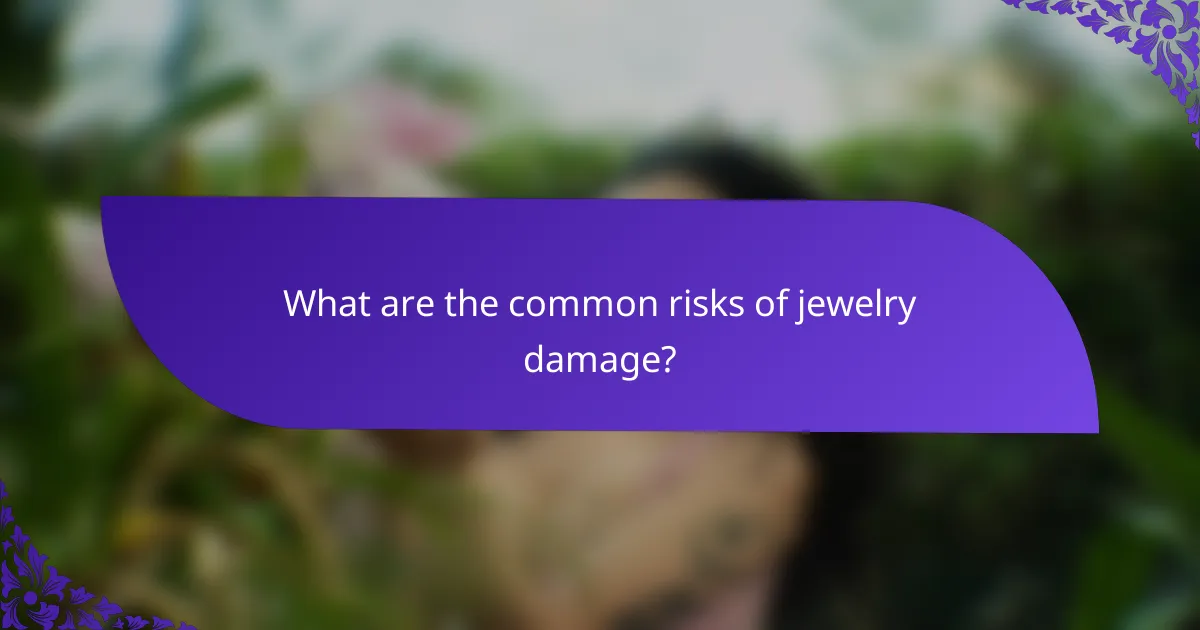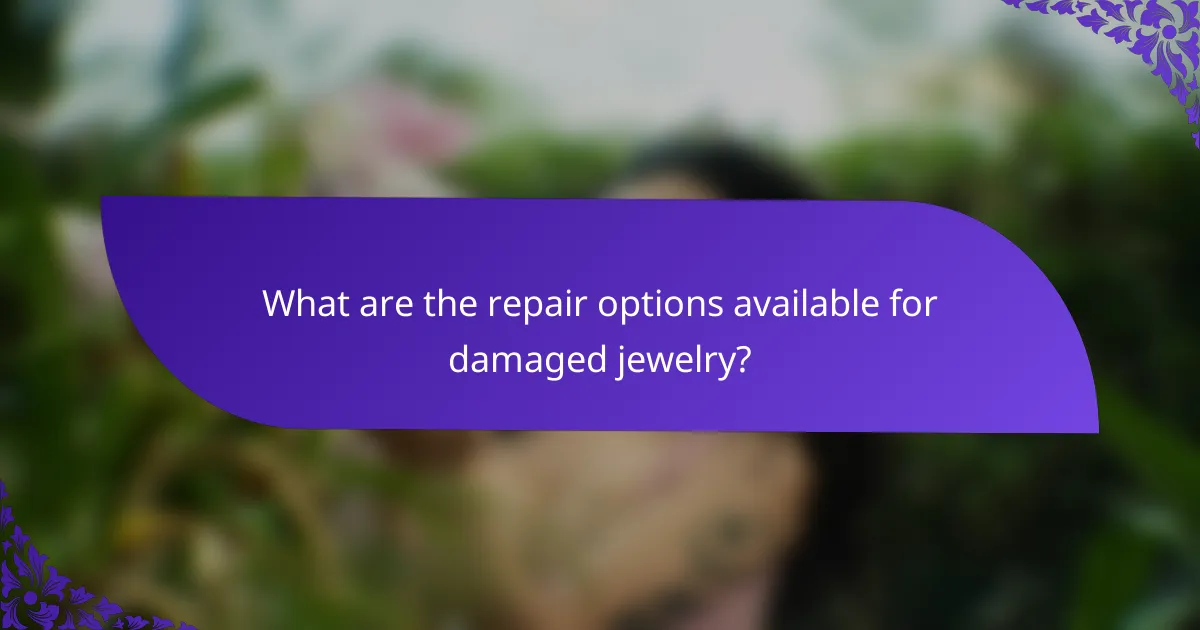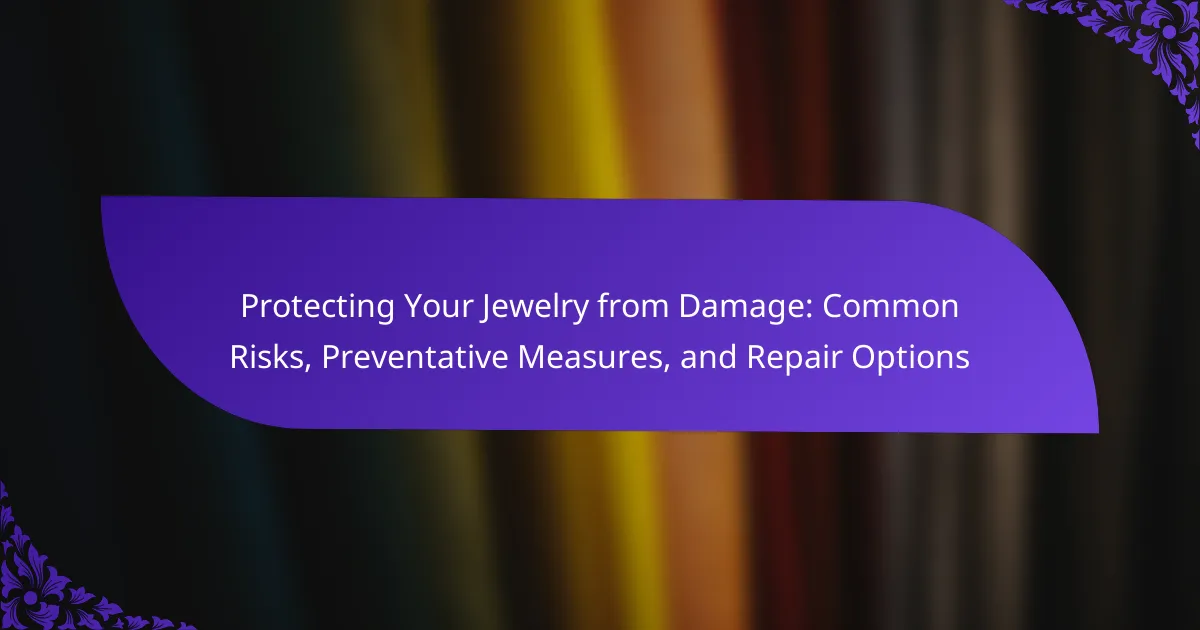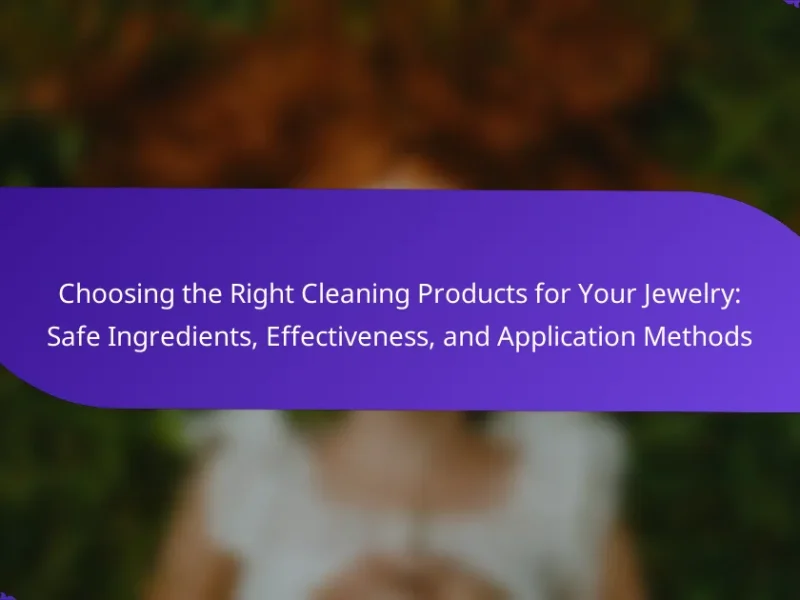Jewelry is susceptible to various types of damage, primarily from physical impact, chemical exposure, and improper storage. Common risks include scratches, tarnishing, and deterioration, often exacerbated by activities such as swimming or exercising. To safeguard jewelry, it is essential to store it properly, avoid harsh chemicals, and engage in regular maintenance. In the event of damage, repair options range from professional services to DIY fixes, depending on the severity of the issue. This article provides a comprehensive overview of these risks, preventative measures, and available repair solutions to help maintain the integrity and appearance of jewelry.

What are the common risks of jewelry damage?
Common risks of jewelry damage include physical impact, exposure to chemicals, and improper storage. Physical impact can occur during everyday activities or accidents, leading to scratches or breakage. Exposure to chemicals, such as household cleaners or cosmetics, can tarnish or corrode certain materials. Improper storage, like leaving jewelry in damp areas, can cause rust or deterioration. Additionally, wearing jewelry during activities like swimming or exercising increases the risk of damage. Each of these risks can significantly affect the appearance and integrity of jewelry.
How can environmental factors affect jewelry?
Environmental factors can significantly affect jewelry by causing physical and chemical damage. Exposure to moisture can lead to tarnishing in metals like silver. Humidity can promote corrosion in certain alloys, weakening the structure. High temperatures can cause gemstones to crack or lose their luster. Additionally, exposure to chemicals, such as cleaning agents or chlorine, can degrade materials and alter finishes. UV light can fade colors in certain gemstones and synthetic materials over time. Dust and dirt can accumulate, requiring more frequent cleaning to maintain appearance. Overall, these environmental factors can shorten the lifespan and diminish the aesthetic value of jewelry.
What types of environmental conditions are most harmful?
Extreme temperatures, high humidity, and exposure to chemicals are the most harmful environmental conditions for jewelry. High temperatures can cause metals to warp or lose their luster. High humidity can lead to tarnishing, especially in silver and other susceptible metals. Chemical exposure, such as chlorine or bleach, can cause irreversible damage to various materials. According to the Jewelers of America, these conditions can significantly shorten the lifespan of jewelry.
How does humidity influence different materials?
Humidity affects different materials by causing expansion, contraction, or degradation. Wood absorbs moisture, leading to swelling and warping. Metals can corrode when exposed to high humidity levels, especially if they contain iron. Fabrics may develop mold or mildew in humid conditions, compromising their integrity. Gemstones can be affected as well; for instance, porous stones may absorb moisture, impacting their appearance and durability. Humidity also influences adhesives used in jewelry, potentially weakening bonds over time. Therefore, understanding humidity’s effects is crucial for preserving various materials, particularly in jewelry.
What physical risks can lead to jewelry damage?
Physical risks that can lead to jewelry damage include impact, abrasion, and exposure to harsh chemicals. Impact occurs when jewelry is struck against hard surfaces, resulting in scratches or breaks. Abrasion happens when jewelry rubs against other materials, causing wear and tear. Harsh chemicals, such as bleach or chlorine, can corrode metal and damage gemstones. Temperature extremes can also cause materials to expand or contract, leading to cracks. Regular exposure to water can loosen settings and weaken structures. Each of these risks can significantly compromise the integrity and appearance of jewelry.
How can everyday activities cause wear and tear?
Everyday activities can cause wear and tear on jewelry through friction, exposure to chemicals, and impact. For instance, wearing rings while typing can create scratches. Exposure to lotions and perfumes can lead to tarnishing or discoloration. Activities like exercising can subject jewelry to sweat, which may degrade materials over time. Additionally, bumping jewelry against hard surfaces can cause dents or breakage. Regularly engaging in these activities increases the likelihood of damage to the jewelry.
What specific actions should be avoided to protect jewelry?
Avoid exposing jewelry to harsh chemicals. Chemicals like bleach and ammonia can damage metals and stones. Do not wear jewelry while swimming or showering. Water can weaken settings and cause tarnishing. Avoid storing jewelry in direct sunlight. Sunlight can fade gemstones and damage materials. Do not wear jewelry during physical activities. Impact can lead to scratches or breakage. Avoid using abrasive cleaning materials. These can scratch surfaces and dull finishes. Do not stack or pile jewelry together. This can cause tangling and scratching.
Why is it important to consider storage risks?
Considering storage risks is crucial for protecting jewelry from damage. Jewelry can be susceptible to environmental factors, theft, and physical wear. Proper storage minimizes exposure to moisture, which can cause tarnishing or corrosion. Additionally, secure storage prevents theft and loss, ensuring items remain safe. Using appropriate storage solutions, like padded boxes or anti-tarnish pouches, enhances protection. According to the Jewelers of America, 30% of jewelry damage occurs due to improper storage. Thus, understanding storage risks is essential for maintaining jewelry’s condition and value.
What are the best practices for storing jewelry safely?
Store jewelry in a cool, dry place to prevent damage. Use a jewelry box with compartments to avoid tangling. Wrap delicate pieces in soft cloth to protect them from scratches. Keep pieces separated to prevent metal from scratching each other. Avoid storing jewelry in direct sunlight, as it can fade gemstones. Use anti-tarnish pouches for silver jewelry to reduce oxidation. Regularly check for loose stones or damage to ensure longevity. Following these practices can significantly extend the life of your jewelry.
How does the choice of storage materials impact jewelry safety?
The choice of storage materials significantly impacts jewelry safety by preventing damage and deterioration. Materials like anti-tarnish cloth and padded compartments reduce exposure to air and moisture. This minimizes tarnishing and corrosion, especially for silver and gold pieces. Hard cases provide protection against physical impacts, reducing the risk of scratches and breakage. Soft materials can lead to tangling and scratching if not properly structured. Additionally, certain plastics can emit harmful chemicals that may tarnish metals over time. Proper storage materials maintain the integrity and appearance of jewelry, ensuring longevity and aesthetic value.

What preventative measures can be taken to protect jewelry?
To protect jewelry, store it in a soft-lined box or pouch. This prevents scratches and tangling. Avoid exposing jewelry to harsh chemicals, including cleaning products and perfumes. These substances can cause damage or tarnishing. Remove jewelry before engaging in physical activities or swimming. This minimizes the risk of loss or damage. Regularly clean jewelry with a soft cloth to maintain its shine. Consider having valuable pieces professionally inspected and cleaned. This can identify potential issues early. Use anti-tarnish strips in storage to prevent oxidation. Following these measures can significantly extend the life of jewelry.
How often should jewelry be cleaned and maintained?
Jewelry should be cleaned and maintained every six months. Regular cleaning helps to remove dirt, oils, and tarnish that accumulate over time. This frequency is recommended by jewelers to ensure the longevity of the pieces. Some items, like rings worn daily, may require more frequent cleaning. For example, engagement rings may benefit from monthly inspections. Proper maintenance can prevent damage and preserve the jewelry’s appearance. Regular care can also identify any loose stones or wear before they become significant issues.
What cleaning methods are safe for different types of jewelry?
Ultrasonic cleaners are safe for most metal jewelry, excluding porous stones. Warm soapy water is safe for gold and silver. A soft cloth can be used for polishing gemstones. Avoid harsh chemicals on pearls and opals. Steam cleaning is effective for diamonds but not for softer stones. Baking soda paste is safe for tarnished silver. Always check manufacturer guidelines for specific pieces.
Why is regular inspection important for jewelry longevity?
Regular inspection is important for jewelry longevity because it identifies wear and damage early. Over time, jewelry can experience issues like loose stones, worn prongs, and tarnishing. Detecting these problems promptly prevents further deterioration. For example, a loose gemstone can fall out if not addressed quickly. Regular checks can also help maintain the overall appearance of the jewelry. It is recommended to inspect jewelry at least twice a year. This practice can extend the life of treasured pieces significantly. Regular maintenance can save on costly repairs in the long run.
What protective accessories can enhance jewelry safety?
Protective accessories that can enhance jewelry safety include jewelry boxes, pouches, and safety chains. Jewelry boxes provide a secure storage solution, preventing scratches and tangles. Pouches made of soft fabric offer additional protection during travel. Safety chains can prevent loss by securing pieces to clothing or bags. These accessories reduce the risk of damage and loss. Proper storage and security measures are essential for maintaining jewelry condition.
How do jewelry boxes and organizers contribute to protection?
Jewelry boxes and organizers protect jewelry by providing a designated storage space. They prevent tangling and scratching of delicate pieces. Many jewelry boxes have padded compartments that cushion items against impact. Organizers often include dividers to separate different types of jewelry. This separation reduces the risk of damage from friction. Additionally, some boxes come with locks for added security against theft. The materials used in jewelry boxes, like velvet or leather, also help prevent tarnishing. Overall, these storage solutions are essential for maintaining the condition of jewelry over time.
What types of protective coatings are available for jewelry?
There are several types of protective coatings available for jewelry. Common options include rhodium plating, which provides a reflective finish and enhances durability. Gold plating is another popular choice, offering a layer of gold over a base metal for a luxurious appearance. Additionally, clear acrylic coatings can protect jewelry without altering its appearance. Enamel coatings provide color and a protective layer, while epoxy coatings offer strong protection against scratches and tarnishing. Each type of coating serves to enhance the jewelry’s longevity and maintain its aesthetic appeal.
How can lifestyle changes contribute to jewelry protection?
Lifestyle changes can significantly enhance jewelry protection. Regularly removing jewelry during activities reduces exposure to potential damage. For instance, taking off rings while washing hands prevents scratches and tarnishing. Storing jewelry in a designated area minimizes the risk of tangling and breakage. Additionally, maintaining a clean environment helps avoid dirt accumulation that can dull surfaces. Wearing jewelry less frequently can also prolong its lifespan by reducing wear and tear. Adopting these habits effectively safeguards jewelry from common risks.
What habits should be adopted to minimize risk?
To minimize risk to jewelry, adopt careful handling and storage habits. Regularly inspect jewelry for damage to catch issues early. Store pieces separately to prevent scratches and tangling. Avoid wearing jewelry during activities that could cause damage, such as exercising or cleaning. Clean jewelry gently and regularly using appropriate methods. Remove jewelry before exposure to harsh chemicals or environments. These habits reduce the likelihood of damage and extend the lifespan of your jewelry.
How does awareness of activities improve jewelry care?
Awareness of activities improves jewelry care by enabling individuals to avoid potential damage. When people understand how different activities can affect their jewelry, they can take proactive measures. For example, wearing rings while washing hands can expose them to harsh soaps. This exposure can lead to tarnishing or weakening of the metal. Additionally, being aware of activities like exercising can help individuals remove jewelry that may get caught or scratched. Knowledge of environmental factors, such as humidity or exposure to chemicals, further aids in proper care. Studies show that proactive care reduces the likelihood of costly repairs or replacements. Therefore, awareness directly correlates with better jewelry maintenance and longevity.

What are the repair options available for damaged jewelry?
Repair options for damaged jewelry include professional repair services, DIY repairs, and replacement of components. Professional jewelers can fix broken chains, replace missing stones, and resize rings. They utilize specialized tools and techniques for effective repairs. DIY repairs may involve using jewelry repair kits for minor fixes, such as reattaching clasps or replacing earring backs. Replacement of components, such as clasps or stones, is also a common option when parts are damaged beyond repair. Each option varies in cost and complexity, depending on the extent of the damage.
What common types of jewelry damage can be repaired?
Common types of jewelry damage that can be repaired include broken clasps, bent or broken prongs, and scratched surfaces. Broken clasps can often be replaced or repaired to restore functionality. Bent or broken prongs can be reshaped or replaced to secure gemstones properly. Scratched surfaces can be polished to restore the original shine. Additionally, loose stones can be reset to ensure they are secure in their settings. These repairs are typically performed by professional jewelers who have the necessary tools and expertise.
How can scratches and dents be addressed effectively?
Scratches and dents on jewelry can be effectively addressed through professional polishing or repair services. Professional jewelers use specialized tools to remove scratches and restore the original surface. This process often involves buffing the metal to eliminate imperfections. For deeper dents, jewelers may reshape the piece to restore its form. Regular maintenance can prevent future damage. Using protective pouches or cases when storing jewelry also helps minimize scratches. According to the Jewelers of America, proper care can extend the lifespan of jewelry significantly.
What are the steps to take for broken clasps or chains?
Assess the damage to the clasp or chain first. Identify if it is completely broken or just loose. Gather necessary tools such as pliers, a jump ring, or a replacement clasp. If the clasp is broken, remove it carefully using pliers. For a broken chain, locate the damaged link. Use pliers to open the link and remove it. Replace the clasp or link with a new one. Close the link securely with pliers. Check the repaired area to ensure it is secure. Regular maintenance can prevent future issues.
When should professional repair services be sought?
Professional repair services should be sought when jewelry is damaged or shows signs of wear. This includes broken clasps, loose stones, or bent metal. If a piece of jewelry is missing a stone, immediate repair is necessary to prevent further loss. Additionally, if there are visible scratches or tarnishing, professional cleaning can restore its appearance. Jewelry that has been exposed to harsh chemicals may also require expert assessment and repair. For antique or heirloom pieces, expert evaluation is crucial to maintain their value and integrity. Seeking professional help ensures that repairs are done correctly and safely.
What should be considered when choosing a jeweler for repairs?
When choosing a jeweler for repairs, consider their experience and qualifications. A jeweler with several years of experience is likely to have honed their skills. Verify if they have certifications from recognized organizations in the jewelry industry. Check customer reviews and testimonials to gauge their reputation. A jeweler with positive feedback is often more trustworthy. Inquire about the types of repairs they specialize in. Some jewelers may focus on specific types of jewelry or materials. Ensure they use quality materials for repairs to maintain the integrity of your pieces. Finally, ask about warranties or guarantees on their work. A jeweler who stands by their repairs is a good sign of reliability.
How can one ensure quality and authenticity in repairs?
To ensure quality and authenticity in repairs, choose a reputable jeweler with certification. Certified jewelers typically possess industry-recognized qualifications. They follow established guidelines for repair processes. Additionally, request to see examples of their previous work. This helps assess their craftsmanship standards. Use original materials whenever possible for authenticity. Original components maintain the piece’s value and integrity. Always ask for a warranty or guarantee on repairs. A warranty indicates confidence in the quality of the work performed. Regularly maintain your jewelry to prevent the need for extensive repairs. Regular maintenance can extend the life of the piece significantly.
What DIY repair options are available for minor damage?
DIY repair options for minor damage to jewelry include cleaning, polishing, and reattaching loose components. Cleaning can be done using mild soap and water to remove dirt and grime. Polishing can restore shine using a soft cloth or specialized jewelry polish. Reattaching loose components, like stones or clasps, can be achieved with jewelry glue or a simple re-threading technique. These methods are effective for minor issues and can often be done at home. Regular maintenance helps prolong the life of jewelry items.
What tools and materials are needed for basic jewelry repairs?
Basic jewelry repairs require specific tools and materials. Essential tools include pliers, wire cutters, and a jeweler’s saw. Pliers are used for bending and gripping wires. Wire cutters assist in trimming excess wire or chain. A jeweler’s saw is necessary for cutting metal or other materials accurately.
Additional tools may include a soldering iron for joining metal pieces. A file helps smooth rough edges after cutting. Tweezers are useful for handling small components. A magnifying glass aids in inspecting intricate details.
Materials needed for repairs often include solder, jump rings, and clasps. Solder is used for joining metal parts securely. Jump rings connect different elements of jewelry. Clasps are essential for fastening necklaces and bracelets.
Having these tools and materials on hand ensures effective and efficient jewelry repairs.
How can one safely attempt to fix common issues at home?
It is essential to follow safety protocols when attempting to fix common issues at home. Always turn off power sources before working on electrical appliances or fixtures. Use appropriate tools for the task to prevent injury. Wear safety goggles and gloves when handling sharp or hazardous materials. Ensure proper ventilation when using chemicals or solvents. If unsure about a repair, consult a professional to avoid accidents. Following these guidelines helps minimize risks during home repairs.
What are the best practices for ongoing jewelry care and maintenance?
Regular cleaning is essential for ongoing jewelry care and maintenance. Use a soft cloth to wipe jewelry after each wear. This removes oils and dirt that can accumulate. For deeper cleaning, soak jewelry in a mild soapy solution for a few minutes. Gently brush with a soft toothbrush to reach intricate areas. Rinse thoroughly and dry with a soft cloth. Store jewelry in a dry, cool place to prevent tarnishing. Use separate compartments or pouches to avoid scratches. Regular inspections for loose stones or damaged clasps can prevent further issues. Professional cleanings should be done annually for valuable pieces.
How can a jewelry care routine be established and maintained?
To establish and maintain a jewelry care routine, regular cleaning and proper storage are essential. Begin by cleaning jewelry with a soft cloth after each wear to remove oils and dirt. Use a gentle jewelry cleaner or a mixture of mild soap and water for deeper cleaning. Rinse thoroughly and dry with a soft cloth. Store jewelry in a cool, dry place, preferably in a lined box or individual pouches to prevent scratches. Avoid exposing jewelry to harsh chemicals or extreme temperatures. Regularly inspect pieces for signs of wear or damage. Address any issues promptly to prevent further damage. Following these steps will help preserve the quality and appearance of jewelry over time.
What tips can help prolong the life and beauty of jewelry?
To prolong the life and beauty of jewelry, proper care and maintenance are essential. Store jewelry in a soft pouch or a separate compartment to prevent scratches. Regularly clean jewelry with a soft cloth to remove dirt and oils. Avoid exposing jewelry to harsh chemicals, as they can damage the metal and stones. Remove jewelry before engaging in activities like swimming or exercising to prevent physical damage. Regular inspections can identify loose stones or wear, allowing for timely repairs. Following these guidelines helps maintain the jewelry’s appearance and integrity over time.
The main entity of the article is jewelry, focusing on the various risks associated with its damage, preventive measures to protect it, and available repair options. Key risks include physical impacts, chemical exposure, and improper storage, all of which can compromise the integrity and appearance of jewelry. The article outlines how environmental factors, such as humidity and temperature, affect different materials, and emphasizes the importance of proper storage and maintenance practices. Additionally, it provides insights into DIY repairs for minor damage and when to seek professional help, ensuring that readers are equipped with essential knowledge for preserving their jewelry.


